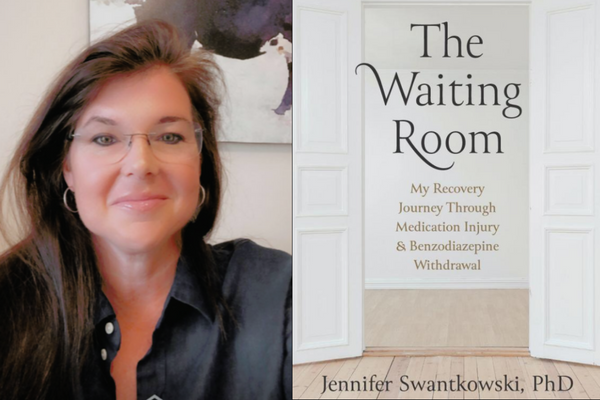With Anxiety And Benzo Withdrawal, There Is A Difference Between Pain And Suffering
This week I’m joined by therapist and author Jennifer Swantowski as she shares her ongoing experience with benzodiazepine withdrawal and anxiety. Jennifer is the author of “The Waiting Room” a most excellent book that anyone dealing with this challenge will find useful and inspiring.
Are You Subscribed To My Newsletter? Recovery tips. Updates on recovery resources. Encouragement. Inspiration. Empowerment. All delivered to your inbox! Subscribe here FREE. More Ways To Listen/Watch My Podcast: Listen on Apple Podcasts | Listen on Spotify | Listen on Amazon Music | Watch on YouTube Helpful Recovery Resources: My Books | FREE Resources | Courses and Workshops | Disordered (with Josh Fletcher)
The Highlights
Jennifer Swantowski, PhD is a Licensed Clinical Social Worker practicing in Texas. After 26 years of successful practice, Jen found herself dealing with what she describes as a “medication injury”. She was unceremoniously dropped into the land of benzodiazepines as a result, and is now working her way through the process of withdrawal from Xanax and the mental health issues that come with that.
Before this experience, Jen has no issues with anxiety disorders. She certainly experienced anxiety like any human does, but she was never faced with the issues she’s dealing with now in the form of “chemically induced” anxiety.
One of the most important things for anyone going through the withdrawal experience is to never lose hope, and to never forget that this does not have to be a lifelong or chronic condition.
“As a therapist I was intellectually aware of the difference between pain and suffering, but when it’s YOUR pain that distinction gets fuzzy real quick.”
Jenn learned to lean on people like Viktor Frankl and the great stoic philosophers to remain connected to the difference between having withdrawal symptoms, and the withdrawal symptoms having you. Working to cultivate an attitude where she did not let her symptoms “have her” was a major pivot point in starting to differentiate between being in pain, and suffering.
“I believe I will be OK one day and there are things I can do help myself … but today may not be that day and I still have to do what I have to do in order to work toward that.
While we can remain connected between the difference between pain and suffering, we do not have to invalidate or minimize our experiences and should not allow anyone else do that either.
Jen talks about how there are days when she doesn’t want to be “in the weeds” but can still find herself there. It happens. In those situations she does her best to give herself some grace, remembering that there is no perfect path through this and that turns and dips are just going to be part of the process.
One of the more profound and healthy perspectives I’ve heard Jen discuss is the desire to come out of this process with a better set of skills and being more capable than she was when she was dumped into the process against her will. As time passes, what can we do to use the experience to learn and grow? When I can’t make IT better right now, is there anything I can do make ME better in the long run?
Maintaining awareness is vital. There is no state of magical enlightenment that one achieves that allows us to float above the fray, but we can work to remain self-aware so we can see when we slip back into victim mindset or wind up flailing around desperately seeking unhelpful reassurance.
Jen talks about how she spent the first part her withdrawal experience “bed surfing” and waiting passively for something to change. Then she discovered that it doesn’t work that way. She had to start acting “as if.” Faking it until she could make it. It mattered. And I found it fascinating to hear a respected and experienced therapist talk about having to abandon her long-held belief that every thought and feeling was to be unpacked and dissected to find meaning. Learning to say, “so what?” to her feelings was a foreign but needed experience.
Jen came to understand that she could not wait to feel comfortable, but had to go into uncomfortable situations in order to move herself forward. When she would get brief glimpses of herself and find moments of relief, she had to use those moments to motivate her and inspire her to keep going. If you can get a glimpse of your real self for a few minutes, then you know that you can get better. Use that!
You know someone is well versed in the world of benzo and/or SSRI withdrawal when they use the term “discontinuation syndrome”. Jen clearly knows what she’s talking about.
Jen had to learn how to be a critical consumer of information online and how to carefully choose her online support systems. But once she had answers to the basic questions, Jen had to turn to sources that were more focused on moving forward and navigating effectively rather than simply comparing symptoms, commiserating, and engaging in victim group mentality.
About Jennifer Swantowski And “The Waiting Room”
Find Jennifer online on her website, her Amazon author page or her Instagram account.
Learn more about her book, “The Waiting Room” on Amazon.
Are You Subscribed To My Newsletter?
Recovery tips. Updates on recovery resources. Encouragement. Inspiration. Empowerment. All delivered to your inbox! Subscribe here FREE.
Helpful Recovery Resources:
My Books | FREE Resources | Courses and Workshops | Disordered (with Josh Fletcher) | Join My Instagram Subscriber Group
Podcast Intro/Outro Music: "Afterglow" by Ben Drake (With Permission)
